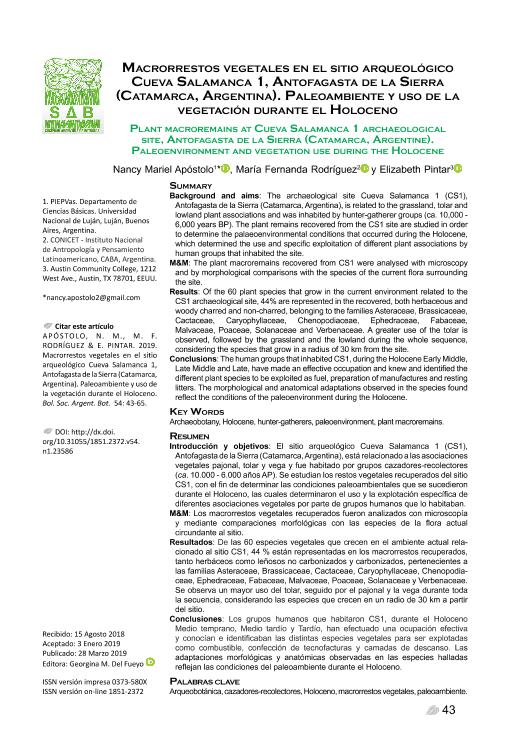Mostrar el registro sencillo del ítem
dc.contributor.author
Apóstolo, Nancy Mariel

dc.contributor.author
Rodríguez, María Fernanda

dc.contributor.author
Pintar, Elizabeth Lucia

dc.date.available
2021-04-19T04:09:06Z
dc.date.issued
2019-03-21
dc.identifier.citation
Apóstolo, Nancy Mariel; Rodríguez, María Fernanda; Pintar, Elizabeth Lucia; Macrorrestos vegetales en el sitio arqueológico Cueva Salamanca 1, Antofagasta de la Sierra (Catamarca, Argentina). Paleoambiente y uso de la vegetación durante el Holoceno; Sociedad Argentina de Botánica; Boletín de la Sociedad Argentina de Botánica; 54; 1; 21-3-2019; 43-65
dc.identifier.issn
0373-580X
dc.identifier.uri
http://hdl.handle.net/11336/130283
dc.description.abstract
Introducción y objetivos: El sitio arqueológico Cueva Salamanca 1 (CS1), Antofagasta de la Sierra (Catamarca, Argentina), está relacionado a las asociaciones vegetales pajonal, tolar y vega y fue habitado por grupos cazadores-recolectores (ca. 10.000 - 6.000 años AP). Se estudian los restos vegetales recuperados del sitio CS1, con el fin de determinar las condiciones paleoambientales que se sucedieron durante el Holoceno, las cuales determinaron el uso y la explotación específica de diferentes asociaciones vegetales por parte de grupos humanos que lo habitaban. M&M: Los macrorrestos vegetales recuperados fueron analizados con microscopía y mediante comparaciones morfológicas con las especies de la flora actual circundante al sitio. Resultados: De las 60 especies vegetales que crecen en el ambiente actual relacionado al sitio CS1, 44 % están representadas en los macrorrestos recuperados, tanto herbáceos como leñosos no carbonizados y carbonizados, pertenecientes a las familias Asteraceae, Brassicaceae, Cactaceae, Caryophyllaceae, Chenopodiaceae, Ephedraceae, Fabaceae, Malvaceae, Poaceae, Solanaceae y Verbenaceae. Se observa un mayor uso del tolar, seguido por el pajonal y la vega durante toda la secuencia, considerando las especies que crecen en un radio de 30 km a partir del sitio. Conclusiones: Los grupos humanos que habitaron CS1, durante el Holoceno Medio temprano, Medio tardío y Tardío, han efectuado una ocupación efectiva y conocían e identificaban las distintas especies vegetales para ser explotadas como combustible, confección de tecnofacturas y camadas de descanso. Las adaptaciones morfológicas y anatómicas observadas en las especies halladas reflejan las condiciones del paleoambiente durante el Holoceno
dc.description.abstract
Background and aims: The archaeological site Cueva Salamanca 1 (CS1), Antofagasta de la Sierra (Catamarca, Argentina), is related to the grassland, tolar and lowland plant associations and was inhabited by hunter-gatherer groups (ca. 10,000 - 6,000 years BP). The plant remains recovered from the CS1 site are studied in order to determine the palaeoenvironmental conditions that occurred during the Holocene, which determined the use and specific exploitation of different plant associations by human groups that inhabited the site. M&M: The plant macroremains recovered from CS1 were analysed with microscopy and by morphological comparisons with the species of the current flora surrounding the site. Results: Of the 60 plant species that grow in the current environment related to the CS1 archaeological site, 44% are represented in the recovered, both herbaceous and woody charred and non-charred, belonging to the families Asteraceae, Brassicaceae, Cactaceae, Caryophyllaceae, Chenopodiaceae, Ephedraceae, Fabaceae, Malvaceae, Poaceae, Solanaceae and Verbenaceae. A greater use of the tolar is observed, followed by the grassland and the lowland during the whole sequence, considering the species that grow in a radius of 30 km from the site. Conclusions: The human groups that inhabited CS1, during the Holocene Early Middle, Late Middle and Late, have made an effective occupation and knew and identified the different plant species to be exploited as fuel, preparation of manufactures and resting litters. The morphological and anatomical adaptations observed in the species found reflect the conditions of the paleoenvironment during the Holocene
dc.format
application/pdf
dc.language.iso
spa
dc.publisher
Sociedad Argentina de Botánica

dc.rights
info:eu-repo/semantics/openAccess
dc.rights.uri
https://creativecommons.org/licenses/by-nc-sa/2.5/ar/
dc.subject
ARCHAEOBOTANY
dc.subject
ARQUEOBOTÁNICA
dc.subject
CAZADORES-RECOLECTORES
dc.subject
HOLOCENE
dc.subject
HOLOCENO
dc.subject
HUNTER-GATHERERS
dc.subject
MACRORRESTOS VEGETALES
dc.subject
PALEOAMBIENTE
dc.subject
PALEOENVIRONMENT
dc.subject
PLANT MACROREMAINS
dc.subject.classification
Otras Ciencias Biológicas

dc.subject.classification
Ciencias Biológicas

dc.subject.classification
CIENCIAS NATURALES Y EXACTAS

dc.title
Macrorrestos vegetales en el sitio arqueológico Cueva Salamanca 1, Antofagasta de la Sierra (Catamarca, Argentina). Paleoambiente y uso de la vegetación durante el Holoceno
dc.title
Plant macroremains at Cueva Salamanca 1 archaeological site, Antofagasta de la Sierra (Catamarca, Argentine). Paleoenvironment and vegetation use during the Holocene
dc.type
info:eu-repo/semantics/article
dc.type
info:ar-repo/semantics/artículo
dc.type
info:eu-repo/semantics/publishedVersion
dc.date.updated
2021-04-06T18:54:01Z
dc.identifier.eissn
1851-2372
dc.journal.volume
54
dc.journal.number
1
dc.journal.pagination
43-65
dc.journal.pais
Argentina

dc.journal.ciudad
Córdoba
dc.description.fil
Fil: Apóstolo, Nancy Mariel. Universidad Nacional de Luján; Argentina
dc.description.fil
Fil: Rodríguez, María Fernanda. Secretaría de Cultura de la Nación. Dirección Nacional de Cultura y Museos. Instituto Nacional de Antropología y Pensamiento Latinoamericano; Argentina. Consejo Nacional de Investigaciones Científicas y Técnicas; Argentina
dc.description.fil
Fil: Pintar, Elizabeth Lucia. Austin Community College; Estados Unidos
dc.journal.title
Boletín de la Sociedad Argentina de Botánica

dc.relation.alternativeid
info:eu-repo/semantics/altIdentifier/doi/https://doi.org/10.31055/1851.2372.v54.n1.23586
dc.relation.alternativeid
info:eu-repo/semantics/altIdentifier/url/https://revistas.unc.edu.ar/index.php/BSAB/article/view/23586
Archivos asociados
